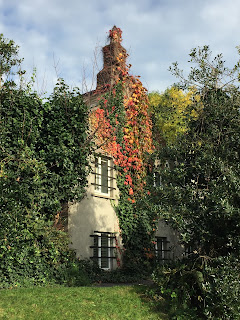For many years in our home on Woodhurst Road in Granger, Indiana, we had a plaque that was on the wall next to our living room fireplace. It read, in Irish:
N'il aon tentéan mar
do theintéan fein.
The translation is, "there is no fireside like your own fireside."
It is an old Irish saying, and this weekend both the poetry and the pertinence of this saying came back to visit us in a very real way.
We had been working our way through a month of settling in here in Dublin, with all the calamity associated with such things – phones, bank accounts, repairs, more repairs, missed contractors, unfinished work... and then, out of the blue, our dear friend Fr. Denis Lennon rang in from Wexford. "I've two tickets to the Opera Thursday next," said he. "Would ye like to be my guest?"
Of course we would. We boarded a bus after the daily 1:05 mass and hightailed it down to the sunny south east. Going to Wexford last weekend was like going home to family – the warm embrace of parishioners we'd known for years, the effervescent joy of a town as it hosted the annual autumn opera pilgrims, the warmth of the seaside and the hum of the parish we had come to love so well.
 |
| Our home from the south, facing Iveagh Gardens |
And then, 48 hours later, it was over, and we were headed – home. Walking through the Door of Humility (more on that later), we approached what has become our new home in Ireland. The shoes of this label, "home," are beginning to fit: here was our kitchen, our pictures up on the walls, our dining room, our little hovels where the computers and reading materials are tucked away.
And there, next to the fireplace, is the little plaque that used to sit next to our hearth in Indiana. It is now perched next to another fireplace, now in the heart of Dublin.
Home is different now. We awake in the morning to seagulls (they gather in Iveagh Gardens in the dawn); when the winds are from the east, you can catch a tinge of salt air from the Irish sea. You have to look a different way when you cross the street (not doing so is at your own peril). Church, and office, are only a dozen steps away from our front door. But even with this proximity, there are miles and miles of work to be done.
"Home." In the midst of a move, it can become an even more powerful symbol than the four-letter snippet we throw around when everything is comfortable. The hearth becomes an anchor. The kitchen becomes a rock.
And all of these – hearth, home, roof, rootedness – are mere flickers of a flame, compared to the home we have in God.
"Home." In the midst of a move, it can become an even more powerful symbol than the four-letter snippet we throw around when everything is comfortable. The hearth becomes an anchor. The kitchen becomes a rock.
And all of these – hearth, home, roof, rootedness – are mere flickers of a flame, compared to the home we have in God.
